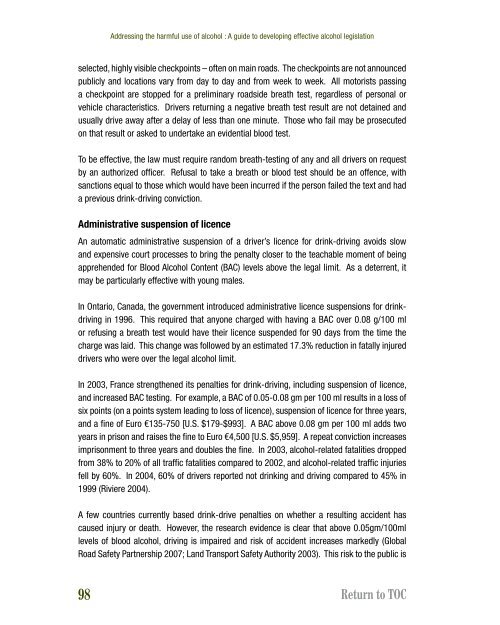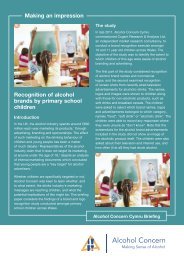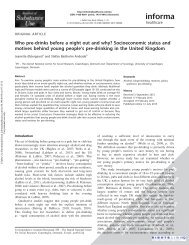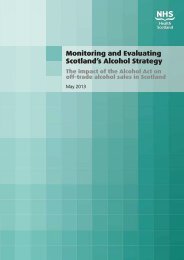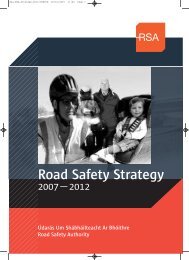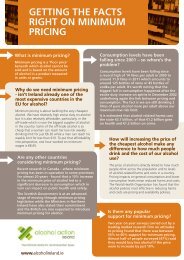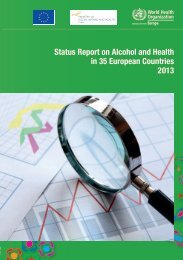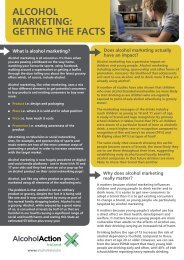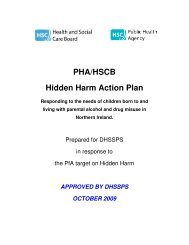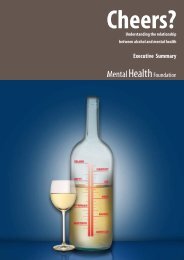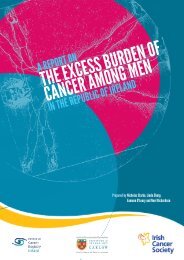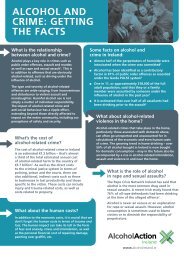Addressing the harmful use of alcohol - WHO Western Pacific Region
Addressing the harmful use of alcohol - WHO Western Pacific Region
Addressing the harmful use of alcohol - WHO Western Pacific Region
Create successful ePaper yourself
Turn your PDF publications into a flip-book with our unique Google optimized e-Paper software.
<strong>Addressing</strong> <strong>the</strong> <strong>harmful</strong> <strong>use</strong> <strong>of</strong> <strong>alcohol</strong> : A guide to developing effective <strong>alcohol</strong> legislation<br />
selected, highly visible checkpoints – <strong>of</strong>ten on main roads. The checkpoints are not announced<br />
publicly and locations vary from day to day and from week to week. All motorists passing<br />
a checkpoint are stopped for a preliminary roadside breath test, regardless <strong>of</strong> personal or<br />
vehicle characteristics. Drivers returning a negative breath test result are not detained and<br />
usually drive away after a delay <strong>of</strong> less than one minute. Those who fail may be prosecuted<br />
on that result or asked to undertake an evidential blood test.<br />
To be effective, <strong>the</strong> law must require random breath-testing <strong>of</strong> any and all drivers on request<br />
by an authorized <strong>of</strong>ficer. Refusal to take a breath or blood test should be an <strong>of</strong>fence, with<br />
sanctions equal to those which would have been incurred if <strong>the</strong> person failed <strong>the</strong> text and had<br />
a previous drink-driving conviction.<br />
Administrative suspension <strong>of</strong> licence<br />
An automatic administrative suspension <strong>of</strong> a driver’s licence for drink-driving avoids slow<br />
and expensive court processes to bring <strong>the</strong> penalty closer to <strong>the</strong> teachable moment <strong>of</strong> being<br />
apprehended for Blood Alcohol Content (BAC) levels above <strong>the</strong> legal limit. As a deterrent, it<br />
may be particularly effective with young males.<br />
In Ontario, Canada, <strong>the</strong> government introduced administrative licence suspensions for drinkdriving<br />
in 1996. This required that anyone charged with having a BAC over 0.08 g/100 ml<br />
or refusing a breath test would have <strong>the</strong>ir licence suspended for 90 days from <strong>the</strong> time <strong>the</strong><br />
charge was laid. This change was followed by an estimated 17.3% reduction in fatally injured<br />
drivers who were over <strong>the</strong> legal <strong>alcohol</strong> limit.<br />
In 2003, France streng<strong>the</strong>ned its penalties for drink-driving, including suspension <strong>of</strong> licence,<br />
and increased BAC testing. For example, a BAC <strong>of</strong> 0.05-0.08 gm per 100 ml results in a loss <strong>of</strong><br />
six points (on a points system leading to loss <strong>of</strong> licence), suspension <strong>of</strong> licence for three years,<br />
and a fine <strong>of</strong> Euro €135-750 [U.S. $179-$993]. A BAC above 0.08 gm per 100 ml adds two<br />
years in prison and raises <strong>the</strong> fine to Euro €4,500 [U.S. $5,959]. A repeat conviction increases<br />
imprisonment to three years and doubles <strong>the</strong> fine. In 2003, <strong>alcohol</strong>-related fatalities dropped<br />
from 38% to 20% <strong>of</strong> all traffic fatalities compared to 2002, and <strong>alcohol</strong>-related traffic injuries<br />
fell by 60%. In 2004, 60% <strong>of</strong> drivers reported not drinking and driving compared to 45% in<br />
1999 (Riviere 2004).<br />
A few countries currently based drink-drive penalties on whe<strong>the</strong>r a resulting accident has<br />
ca<strong>use</strong>d injury or death. However, <strong>the</strong> research evidence is clear that above 0.05gm/100ml<br />
levels <strong>of</strong> blood <strong>alcohol</strong>, driving is impaired and risk <strong>of</strong> accident increases markedly (Global<br />
Road Safety Partnership 2007; Land Transport Safety Authority 2003). This risk to <strong>the</strong> public is<br />
98 Return to TOC


